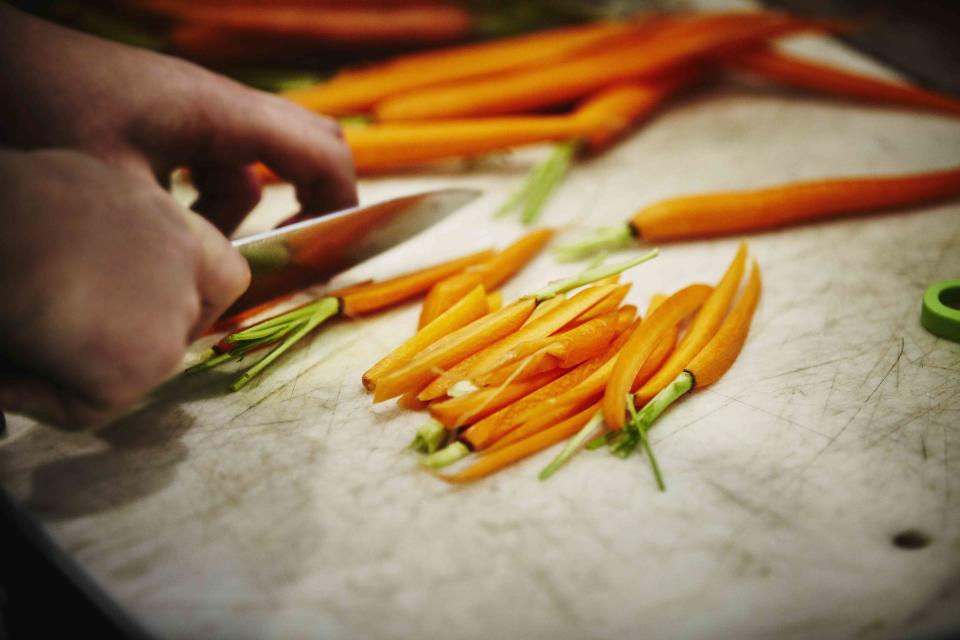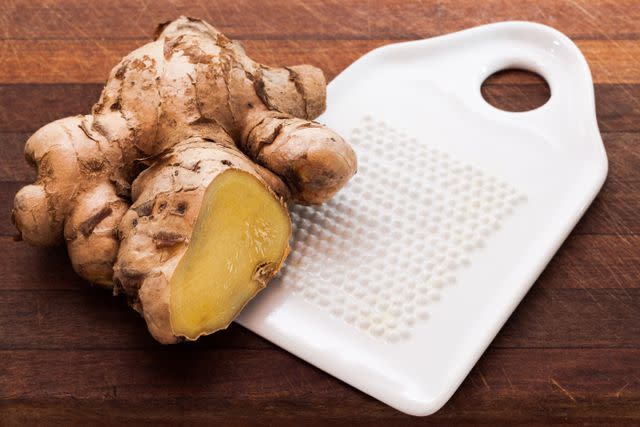6 Essential, Sustainable Shortcuts in the Kitchen
Cooking from scratch is often the greenest option, but time can be an issue. These shortcuts can help.

In my days of homemade butter and baking bread from scratch (read: before children), I bristled at the memory of my generation's regular subjection to last century's number-one secret ingredient (canned cream of mushroom soup) and the regular reliance on frozen vegetables. Two kids and a full-time job later, I’m thinking, wow, a can of soup fixes everything, and by the way, where can I fit in another freezer around here?
Sustainability influencers often tout their cooked-from-scratch creations—but let's be honest, it's not practical for everyone. Yes, cooking from scratch gives you control over the ingredients and allows you to opt for, say, organic or non-GMO products if you desire. Cooking from scratch often allows for more locally produced foods and way less packaging. It also gives you control over how you employ your food waste—you can be sure it gets used up or composted, which is more than can be said for many large food manufacturers.
But, it can take time—a valuable asset that not everyone can spare. Fortunately, you need not surrender to processed convenience foods to save time and money in the kitchen. Even if spending time in the kitchen is one of your favorite pastimes, spending less of it on mundane chores will leave you more time for the pleasurable tasks at hand, like eating and drinking.
Here are six places to start:
1. Master Some Signature Sauces
In The Art of Simple Food, Alice Waters recommends four essential sauces that you can practically make in your sleep: vinaigrette, salsa verde, aioli, and herb butter. I couldn’t agree more. Having a stash of sauces and condiments at your beck and call can whittle kitchen time by allowing you to deftly dress up simple preparations, and homemade sauces are free of ingredients that require a science degree to understand. There is no small joy in whipping up a sauce without the mess and headache that comes with holding the cookbook open with one while trying to measure and stir with the other.
Try one of Waters’ sauces, or learn a pesto by heart. Pesto is versatile way beyond pasta; it can be used on vegetables, sandwiches, soups, dips, spreads, marinades, eggs, you name it. And once you master pesto, you can play around with other herbs, nuts, and flavors in the mix as well; my go-to pesto is always spiked with jalapeno.
Related: How to Make Pesto With a Variety of Greens
Quick and Simple Pesto: Place 2 large cloves of garlic in the bottom of a blender or food processor. Add 3 cups very firmly packed fresh basil leaves, 2 tablespoons grated Parmesan cheese, and 1 cup olive oil. Process for 10 seconds. Add 1⁄2 cup pine nuts, briefly process, and season to taste with salt and pepper. [Note: Pine nuts are currently exorbitant in price; almonds and cashews are great replacements, as are most nuts.]
Learn More: Learn to Make Some of These 17 Essential Sauces
2. Make the Freezer Your Friend
Frozen food has gotten a bum rap, but all frozen food need not be equated only with TV Dinners and petrified pizza. I know many a chef who secretly (and not so secretly) swear by frozen peas over fresh ones. I have found the freezer to be an invaluable tool in preserving local produce because me and canning, sadly, don't get along very well.
The freezing process itself does not destroy nutrients, and although the texture of some items, like berries, might not translate exactly the same after thawing, the flavor alone of farm-stand strawberries in the middle of winter is a thing of sheer beauty. By preserving local products, you cut down on imported produce off-season, which means cutting down on your food miles and skipping the extra cost of imported produce. And it means having food prepped and ready to go when you need it.
Related: The 15 Foods I Most Frequently Freeze
Here are the basics:
Use the freshest produce you can find, and freeze it as soon as you can—the quicker
the better.Make sure to wash and dry everything thoroughly. Remove pits and cut into uniform-sized pieces.
Use containers, freezer bags, or a vacuum seal system—and remember to leave
headroom for expansion.If you are watching your use of plastic, the ever-popular Ball makes freezer-safe glass
jars—heros! Label with contents and date.When ready to use, defrost in the refrigerator.
Related: How to Freeze Food Without Plastic
3. Quicken Kitchen Clean Up
I am engulfed by a recurring fantasy after each and every dinner party; it involves not a romance-novel heartthrob, but throwing every last plate, pan, and spoon in the trash; just tossing the whole shebang. Instead, alas, it’s a more prudent plan to keep “clean” in mind when cooking. Clean as you go, even if that just means scraping and putting dirty items neatly in the sink (bonus points for getting them in the dishwasher). Also, look at your gameplan and figure out which pans, pots, and bowls you can use more than once without cleaning in-between (use the scrambled egg bowl for pancake batter; steam broccoli in the pasta pot, etc.) to reduce items requiring cleaning.
In terms of dishwashing, save time and water by skipping the rinse; simply scrape instead. Most people pre-rinse dishes before loading them into the dishwasher, yet modern dishwashers—certainly those purchased within the last 5 to 10 years—do a superb job of cleaning even heavily soiled dishes. Many manufacturers, in fact, recommend not rinsing. (This, I know, is a contentious topic! Let your machine's owner's manual be the final judge—all of mine have instructed to simply scrape.)
Also to save time and water, wash only full loads. The dishwasher uses the same amount of water whether it’s half-full or completely full. Putting dishes in the dishwasher throughout the day and running it once in the evening will use less water and energy than washing dishes by hand throughout the day.
4. Pre-Prep Your Produce
After a big grocery or farmers market shop, wash and prepare all of your produce in one fell swoop. This sets you up for the week and means you only have one round of veggie-prepping clean-up rather than a bout after each meal–while saving you money on pre-packaged produce.
For leafy greens, rinse very well and dry in a salad spinner. I wrap them in a tea towel and store them in the crisper drawer. Cut produce in the way in which you are most likely to use it: dice carrots, make celery sticks, slice cucumbers, cut broccoli into florets—whatever will work for you.
In terms of peeling, if you buy organic produce you don’t need to remove the peel from thin-skinned fruits and vegetables. Pass the peeling on apples, tomatoes, eggplant, pears, potatoes, cucumbers, and most fruits and vegetables where the skin is thin or edible. Much of the insoluble fiber and many of the antioxidants and vitamins are located in the skin.
If you have small children, prepare some of the produce with the aim of freezing it to use as a "cool-down tool." Freeze rinsed blueberries, sliced bananas, or diced strawberries to add to piping hot oatmeal–they defrost and quickly bring the oatmeal to eating temperature. The same thing can be done to peas and other vegetables to be added to pasta, soups, etc.
5. Become a Mix Master, Make Your Own Baking Mixes
Unbeknown to many, there is a happy place located somewhere between the box of Bisquick and the chaos of a baking mess. Welcome to the homemade mix. There are a number of pancake/muffin/waffle mix recipes floating around the Internet, but this “Fauxquick” one is great because you can use it for any Bisquick recipe.
6 cups all-purpose flour (swap out any portion of this for whole wheat flour)
3 Tbsp baking powder
1 Tbsp baking soda
3 Tbsp sugar
1 Tbsp salt
1 cup vegetable shortening (opt for one that is free of hydrogenated oils and has no trans-fats)
Sift everything except shortening into a mixing bowl. Add shortening and mix with a hand mixer until the mixture is fine and free of lumps. Store in an airtight container in your refrigerator for up to two months.
6. Tout Your Tools

I’ve never been much of an Inspector Gadget in the kitchen, but there are a handful of tools that I live and die by–they end up saving a surprising amount of time and a load of agita. I know a lot of people can get by with a good knife and cutting board, but these durable and versatile tools get my vote.
Tongs. A simple pair of kitchen tongs can become an extension of your hand, like very fragile fingers that can take extreme heat. I feel like Edward Scissorhands with mine. Use your tongs for everything from getting pizza out of the oven, to tossing salad, roasting peppers on the burner, stirring pasta, or whatever you don’t want to do with your fingers.
A good garlic press. If you use a lot of garlic and don’t have a good garlic press? Poor you! You don’t know how badly you need one. I seldom recommend specific brands, but she’s a beaut: the Rosle Garlic Press. This high-tech stainless-steel presses unpeeled cloves into smithereens, and unlike other presses, it doesn’t leave any garlic left in the press, just the skin that you didn’t have to peel! (Also washes wonderfully clean in the dishwasher.)
A good vegetable peeler. I know I said to skip peeling most of your produce, but there will be times you want to peel, and a bad vegetable peeler is an exercise in futility and frustration. A good vegetable peeler is a dream.
Ceramic ginger grater. This very low-tech tool is one of my all-time favorites. It’s a little bumpy slip of porcelain, and it pretty much performs miracles. No more peeling and fine-dicing ginger. Just rub it, unpeeled, on this grater, and voila, an easy perfect mound of chunky ginger puree. I have also adopted it for grating nutmeg and recently found that it can stand in as a citrus zester.
Box grater. I dedicated a whole story to this friend: 18 Great Uses for the Glorious Box Grater.
Rice cooker. This always seemed to me like an utterly unnecessary tool for anyone in possession of a pot and a stove. But then I was given one, and it’s been true love ever since. It is an extraordinary multitasker, it can make the best oatmeal, be used as a one-pot meal steamer; make poached fruit or applesauce; make slow-cooking soups; make stir-free risotto, and so much more. And lest we forget, it makes perfect rice.

